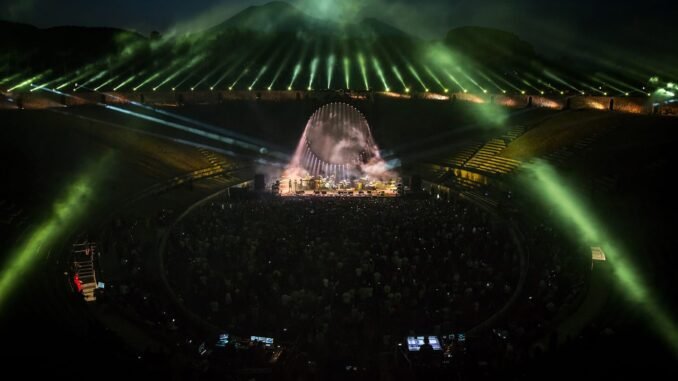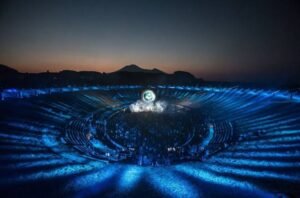
Eight Years On: Remembering
David Gilmour Live at Pompeii
Eight years have now passed since the release of David Gilmour Live at Pompeii, a stunning recording that captured two extraordinary concerts staged in July 2016 at one of the most historic and atmospheric venues on earth—the ancient Roman amphitheater in Pompeii. For both David Gilmour and his fans, the shows carried an enormous sense of history, continuity, and emotional weight. After all, this was the very site where Pink Floyd had filmed their legendary 1971 performance movie Live at Pompeii, a film that became a touchstone for generations of music lovers.

When news first broke that Gilmour would return to Pompeii, there was disbelief mixed with excitement. The venue itself, nestled in the ruins of the city destroyed by Vesuvius in 79 A.D., had never been open to a rock audience in such a way before. In 1971, Pink Floyd had performed to an empty amphitheater for director Adrian Maben’s camera. This time, however, thousands of fans were invited to witness a living legend revisit the same stage with half a century of experience and a lifetime of music behind him. For those lucky enough to attend, it was nothing short of a pilgrimage.
A Concert for the Ages
The concerts took place on July 7 and 8, 2016. The Roman amphitheater, the oldest surviving in the world, provided an otherworldly setting. As the sun set and darkness fell, lights danced across the ancient stone, and the night sky framed the stage. David Gilmour, then 70 years old, stood at the center, his iconic black Stratocaster in hand, delivering a setlist that balanced solo material with the Pink Floyd classics that had made the site so famous.
The shows opened with “5 A.M.” and “Rattle That Lock” from Gilmour’s then-recent solo album, before weaving into Pink Floyd staples like “Wish You Were Here,” “Money,” and “Shine On You Crazy Diamond.” But perhaps the most powerful moments came with “Echoes,” the sprawling, 23-minute epic performed in full for the first time in a decade. It was a deliberate nod to 1971, when the same song had been filmed on the very stones beneath Gilmour’s feet. Fans who were there have described the performance as transcendent—something that went beyond nostalgia and became a deeply spiritual moment.
Capturing the Magic
Thankfully, the shows were professionally filmed and later released as David Gilmour Live at Pompeii in September 2017. Directed by Gavin Elder, the concert film and accompanying album preserved the magic for those who couldn’t make the trip to Italy. The release was more than just a concert film—it was a testament to Gilmour’s artistry, his connection to the past, and the enduring power of the music he created with Pink Floyd and as a solo artist.
The visuals in the film captured not just the performance, but the interplay between music and place. The amphitheater was lit in dazzling displays of color, lasers cut through the night sky, and the ruins themselves seemed to echo with sound. One striking moment was the performance of “Comfortably Numb,” where Gilmour’s soaring guitar solo was paired with pyrotechnics erupting into the dark, an unforgettable image etched into the minds of those who saw it.
The Emotional Weight of Pompeii
What made the Pompeii concerts so special was their symbolism. Pink Floyd’s original Live at Pompeii was deliberately intimate, stripped of an audience, focused on the band’s raw performance in a silent, haunting ruin. In contrast, Gilmour’s 2016 concerts filled the space with thousands of voices, cheers, and applause. It was as if the ghosts of the past had been joined by the living, completing a circle that began 45 years earlier.
For fans who attended, it wasn’t just another concert—it was history. Many described it as a once-in-a-lifetime event, something akin to a spiritual journey. To hear Gilmour’s unmistakable guitar tones reverberate against the same stone walls that once hosted gladiators was surreal. To witness “Echoes” in that setting, with its themes of time, space, and human connection, was profoundly moving.
Eight Years Later
Now, eight years since the film’s release, David Gilmour Live at Pompeii remains a cherished document. It is more than a concert movie—it’s a bridge between eras, an affirmation of the timelessness of great music. Younger fans who weren’t alive in 1971 were given the chance to connect with that history through Gilmour’s return. Older fans found closure, a sense of continuity that honored Pink Floyd’s legacy while celebrating Gilmour’s individual artistry.
Looking back, it is clear that these shows represented a high point in Gilmour’s solo career. While he had already performed at stunning venues such as the Royal Albert Hall and in cities across the globe, Pompeii was different. It wasn’t just a venue; it was a story, a symbol, a return to sacred ground. That’s why the recordings continue to resonate today.
Did You Go?
For those who were fortunate enough to be in attendance, the memories must still feel vivid: the journey to the ruins, the hush as the lights dimmed, the thrill of hearing the first notes ring out. Even for those who only experienced it through the album or film, David Gilmour Live at Pompeii remains a moving reminder of how music can transcend time, place, and even generations.
Eight years on, one thing is certain: Pompeii was not just a concert. It was an event that will forever stand as one of the most spectacular chapters in rock history.
Leave a Reply